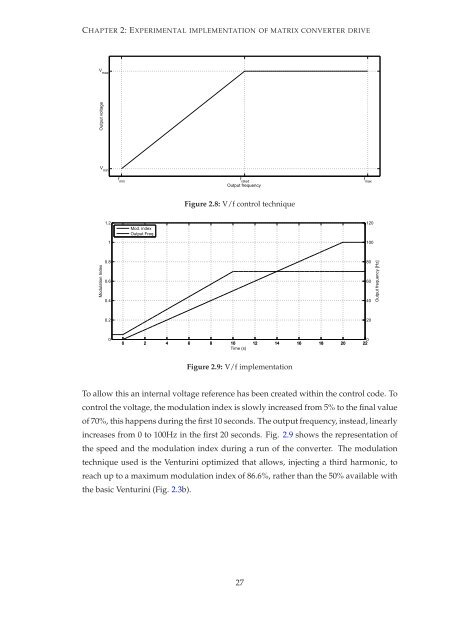PDF (Thesis) - Nottingham eTheses - University of Nottingham
PDF (Thesis) - Nottingham eTheses - University of Nottingham
PDF (Thesis) - Nottingham eTheses - University of Nottingham
You also want an ePaper? Increase the reach of your titles
YUMPU automatically turns print PDFs into web optimized ePapers that Google loves.
CHAPTER 2: EXPERIMENTAL IMPLEMENTATION OF MATRIX CONVERTER DRIVE<br />
V max<br />
Output voltage<br />
Modulation Index<br />
V min<br />
1.2<br />
1<br />
0.8<br />
0.6<br />
0.4<br />
0.2<br />
0<br />
f min<br />
Mod. index<br />
Output Freq.<br />
f<br />
rated<br />
Output frequency<br />
Figure 2.8: V/f control technique<br />
0 2 4 6 8 10<br />
Time (s)<br />
12 14 16 18 20 22 0<br />
Figure 2.9: V/f implementation<br />
To allow this an internal voltage reference has been created within the control code. To<br />
control the voltage, the modulation index is slowly increased from 5% to the final value<br />
<strong>of</strong> 70%, this happens during the first 10 seconds. The output frequency, instead, linearly<br />
increases from 0 to 100Hz in the first 20 seconds. Fig. 2.9 shows the representation <strong>of</strong><br />
the speed and the modulation index during a run <strong>of</strong> the converter. The modulation<br />
technique used is the Venturini optimized that allows, injecting a third harmonic, to<br />
reach up to a maximum modulation index <strong>of</strong> 86.6%, rather than the 50% available with<br />
the basic Venturini (Fig. 2.3b).<br />
27<br />
f max<br />
120<br />
100<br />
80<br />
60<br />
40<br />
20<br />
Output frequency [Hz]
















